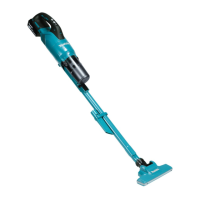16 ENGLISH
MAINTENANCE
CAUTION: Always be sure that the tool is
switched o and the battery cartridge is removed
before attempting to perform inspection or
maintenance.
NOTICE: Never use gasoline, benzine, thinner,
alcohol or the like. Discoloration, deformation or
cracks may result.
To maintain product SAFETY and RELIABILITY,
repairs, any other maintenance or adjustment should
be performed by Makita Authorized or Factory Service
Centers, always using Makita replacement parts.
After use
CAUTION: Putting the cleaner against the
wall without any other support may cause the
cleaner to fall down, resulting in personal injury
or damage to the cleaner.
► Fig.20
Regular maintenance
NOTICE: Clean the lters in the cyclone unit
when they become clogged. Continuing use in
the clogged condition may result in heating or motor
malfunction.
NOTICE: Do not blow dust sticking on the
cleaner and lters by air duster. It brings dust into
the housing and causes failure.
Routine maintenance is required to restore normal
operating conditions.
Cleaner body
Wipe o the outside (cleaner body) of the cleaner using
a cloth dampened in soapy water, and clean out the
suction openings.
► Fig.21
Cyclone unit and lters
NOTICE: Dust o and clean out inside the
cyclone unit and lters, when suction perfor-
mance becomes less eective regardless of the
amount of dust collected in the dust case.
NOTICE: After washing lters, dry them thor-
oughly before use. Insuciently dried lters may
cause poor suction and shorten the service life of the
motor.
NOTICE: After cleaning lters and sponge sheet,
be sure to re-install them before use. If you use the
cleaner without lters and sponge sheet, dust comes
into the motor housing and causes malfunction.
Cyclone unit
1. Tap the cyclone unit several times with your hand
to remove dust adhering to the inner surface of the
cyclone unit and lter.
► Fig.22: 1. Cyclone unit
2. With the suction inlet pointing downwards, turn the
cyclone unit as shown in the gure aligning the pointer
on the cyclone unit with that on the cleaner body to
disengage the lock. Then detach the cyclone unit from
the cleaner body slowly and straightly.
► Fig.23: 1. Cyclone unit 2. Suction inlet 3. Pointers
4. Filter
NOTE: Dust may y out when the cyclone unit is
disassembled. It is recommended to place a garbage
bag underneath the cyclone unit.
3. Dust o inside the cyclone unit and lter.
► Fig.24
4. Place the cyclone unit back onto the cleaner body,
aligning the pointer on the cyclone unit with that on the
cleaner body. Then turn the cyclone unit as shown in
the gure until it is secured in place.
► Fig.25: 1. Cyclone unit 2. Cleaner body 3. Pointers
High performance lter
Optional accessory
1. Disassemble the cyclone unit from the cleaner
body.
2. Hold the mounting end of high performance lter
and pull it apart from the cleaner body.
► Fig.26: 1. High performance lter 2. Cleaner body
3. Wipe and shake dust o the high performance
lter by hand.
► Fig.27
4. Wash the high performance lter in soapy water
when it is clogged with dust and dirt. Dry it out thor-
oughly in the shade before use.
► Fig.28
NOTE: Avoid fastening the attachment end (rubber
sealing ring) of high performance lter when hanging
it up for drying.
5. Hold the mounting end of high performance lter
and squeeze it back into the cleaner body.
► Fig.29: 1. High performance lter 2. Cleaner body
HEPA lter
Optional accessory
NOTICE: Do not rub or scratch the HEPA lter
with hard objects such as a brush and a paddle.
1. Disassemble the cyclone unit from the cleaner
body.
2. Hold the mounting end of HEPA lter (covered with
high performance prelter) and pull it apart from the
cleaner body.
► Fig.30: 1. HEPA lter (covered with high perfor-
mance prelter) 2. Cleaner body

